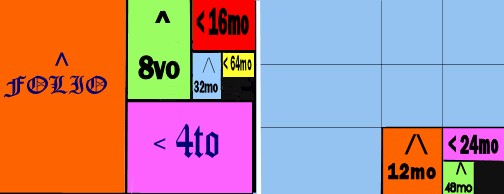Top Banner
- TomFolio.com
-


| Abbreviation | Format Name | Description |
| Folio | Folio | A book up to 15" tall |
| 4to | Quarto | A book up to 12" tall |
| sm4to | Small Quarto | A book up to 10" tall |
| 8vo | Octavo | A book up to 9 3/4" tall |
| sm8vo | Small Octavo | A book up to 8" tall |
| 12mo | Duodecimo | A book up to 7 3/4" tall |
| 16mo | Sextodecimo | A book up to 6 3/4" tall |
| 24mo | Vigesimo-quarto | A book up to 5 3/4" tall |
| 32mo | Trigesimo-segundo | A book up to 5" tall. |
| 48mo | Quadragesimo-octavo | A book up to 4" tall |
| 64mo | Sexagesimo-quarto | A book up to 3" tall |
| Seldom Seen Large Animals | Elephant Folio | A book up to 23" tall |
| Atlas Folio | A book up to 25" tall | |
| Double Elephant Folio | A book up to 50" tall |
 Each Line Inside the Sheet is a Fold.
Each Line Inside the Sheet is a Fold.| FORMATS | TALL | OBLONG | SMALL | NARROW | SQUARE | EXTRA |
|
TALL FORMATS Folio, 8vo., 24mo., 32mo. |
Same shape, but proportionally a little taller | Same shape and dimensions, but bound along one of the shorter edges | Same shape, but proportionally a little shorter | Same height, but a little narrower | Not Applicable | Same shape, but proportionally more than just a little taller, shorter, etc. |
| SQUARISH FORMATS 4to., 12mo., 16mo., 48mo., 64mo. |
Same shape, but proportionally a little taller | Same shape and dimensions, but bound along one of the shorter edges | Same shape, but proportionally a little shorter | Not Applicable | Just enough wider to make a square format. | Same shape, but proportionally more than just a little taller, shorter, etc. |

